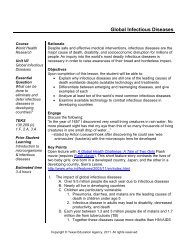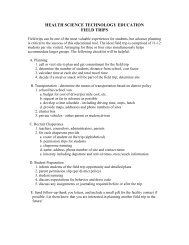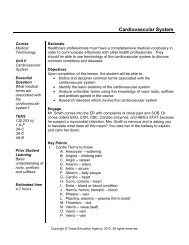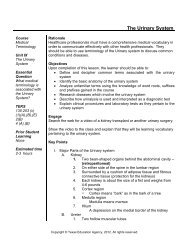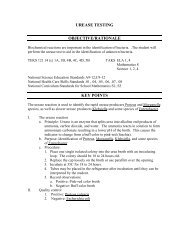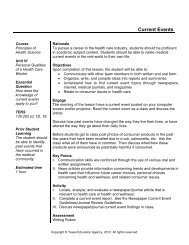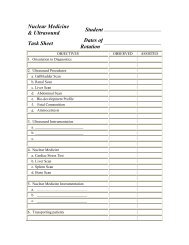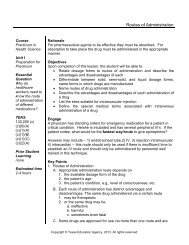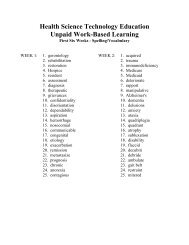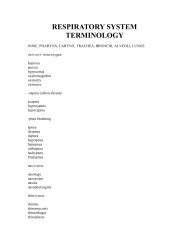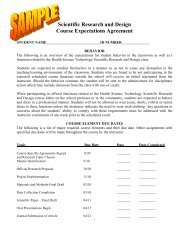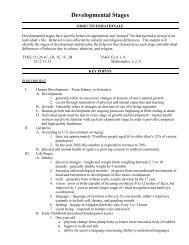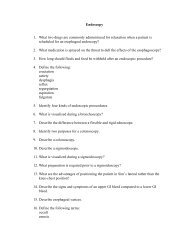Bacteria Growth Characteristics - haspi
Bacteria Growth Characteristics - haspi
Bacteria Growth Characteristics - haspi
You also want an ePaper? Increase the reach of your titles
YUMPU automatically turns print PDFs into web optimized ePapers that Google loves.
<strong>Bacteria</strong> <strong>Growth</strong> <strong>Characteristics</strong><br />
Course<br />
Medical<br />
Microbiology<br />
Unit VI<br />
Concepts of<br />
Medical<br />
Microbiology<br />
Essential<br />
Question<br />
How can we<br />
macroscopically<br />
identify<br />
bacteria?<br />
TEKS<br />
130.207(c)1A,<br />
2FGH, 4BCEF,<br />
5E<br />
Rationale<br />
Recognizing colony growth characteristics and<br />
biochemical reactions<br />
to<br />
various media is important in identifying bacteria.<br />
Objectives<br />
Upon completion of this lesson, the student will be able to:<br />
Plate known bacteria and observe for colony characteristics and<br />
biochemical reactions<br />
Engage<br />
Present handout of the photos below<br />
(or a similar collection) and ask<br />
students to identify the different breeds. Then explain:<br />
Much in the same way we can recognize different breeds of dogs by<br />
appearance, microbiolog<br />
ists can also recognize different species of bacteria<br />
by macroscop<br />
ic (naked eye – colonyy appearance) and microscopic<br />
appearance (usually gram<br />
stain under a microscope).<br />
Prior Student<br />
Learning<br />
<strong>Growth</strong> of<br />
Microorganisms<br />
Estimated time<br />
Introduction<br />
of<br />
key points and<br />
lab review: 30-<br />
50 minutes<br />
Lab procedure:<br />
30-50 minutes<br />
(24hr. incubation<br />
needed before<br />
observation)<br />
All photos courtesy of www.CDC.gov<br />
Key<br />
Points<br />
I. Introduction<br />
A. <strong>Bacteria</strong> have different characteristicc morphology of their colonies.<br />
These colonies<br />
will take on additional characteristics that aid in<br />
differentiation depending<br />
on the media/agar used for growth.<br />
II. Colony characteristics:<br />
A. The Colony Surface (or texture)<br />
1. smooth<br />
2. rough<br />
3. wrinkled<br />
Copyright © Texas Education Agency, 2011. All rights<br />
reserved.
4. glistening<br />
B. Colony Color<br />
1. Describe the color of the colony<br />
a. soluble: does the color diffuse into the media/agar?<br />
b. insoluble: does the color stay within the colony?<br />
c. color: white-white, white-gray, light purple, yellow-brown,<br />
etc.<br />
C. Consistency<br />
1. Take an inoculating loop and poke at the colony; which word<br />
most closely describes it?<br />
a. mucoid: resembling mucous<br />
b. dry: crusty, brittle<br />
c. soft: butter-like consistency<br />
D. Visual characteristics – appearance in light<br />
1. Translucent: see-through<br />
2. Opaque: no light shines through<br />
3. Iridescent: rainbow colors in reflected light<br />
4. Dull: no shine to the colony<br />
5. Shiny: reflects light<br />
E. Shape of the colony (See handout for pictures)<br />
1. Circular<br />
2. Irregular<br />
3. Spindle<br />
4. Filamentous<br />
5. Spreading<br />
F. Scent of the colony (that lovely after a fresh rain smell is new<br />
bacterial growth)<br />
1. No Odor<br />
2. Musty<br />
3. Sour<br />
4. Grapes or corn tortillas (very typical of Pseudomonas)<br />
G. Height of colony (See handout for pictures)<br />
1. Raised<br />
2. Flat<br />
3. Convex<br />
4. Heaped<br />
5. Sunken<br />
III.<br />
Media and Biochemical Reactions<br />
A. MSA-Mannitol Salt Agar: a selective medium for the isolation of<br />
Staphylococci species. It contains a 7.5% NaCl that inhibits the<br />
growth of most gram-negative and gram-positive microorganisms.<br />
MSA contains beef extract as a nutrient and phenol red indicator.<br />
When Staphylococcus aureus is grown, it ferments the sugar<br />
Copyright © Texas Education Agency, 2013. All rights reserved.
mannitol, producing yellow colonies. Those Staphylococcus<br />
species that do not ferment mannitol, remain as small red colonies<br />
and the plate remains pink to red.<br />
B. MAC-MacConkey: a selective, differentiating medium for the<br />
isolation of gram-negative bacilli and differentiation of lactose<br />
fermenters from non-lactose fermenters. It contains bile salt and<br />
crystal violet that inhibit the growth of gram-positive bacteria. If<br />
the microorganism can ferment lactose, the colonies appear pink<br />
to red in color and if it cannot ferment lactose, the colonies appear<br />
clear. The medium also contains lactose and neutral red indicator.<br />
C. BLD-Sheep blood agar: an enriched, non-selective medium. It is<br />
trypticase soy agar with 5% sheep red blood cells added to it.<br />
Gram-positive and gram-negative bacteria can grow on this<br />
medium. Hemolytic patterns of certain bacteria may be seen on<br />
the plate:<br />
1. Alpha hemolysis: incomplete hemolysis; greening of the<br />
medium<br />
2. Beta hemolysis: total clearing of the medium<br />
3. Gamma hemolysis: non-hemolytic; no change in the color of<br />
the medium.<br />
D. EMB-Eosin methylene blue agar: a selective, differential medium<br />
for the isolation of gram-negative bacilli and differentiation of<br />
lactose fermenters from non-lactose fermenters. The medium<br />
contains lactose, eosin dye, and methylene blue dye. The dyes<br />
are toxic to gram-positive bacteria. When bacteria ferment the<br />
lactose, the pH decreases in the medium and the medium<br />
changes to a purple color. Gram-negative bacteria that ferment<br />
lactose appear with a green metallic sheen. Those that cannot<br />
ferment lactose appear clear on the medium.<br />
E. CNA-Colistin-nalidixic acid agar: for isolation of gram-positive<br />
bacteria. The medium contains sheep blood agar and the<br />
antibiotics colistin and nalidixic acid added. Colistin disrupts the<br />
cell membrane of gram-negative microorganisms and the nalidixic<br />
acid blocks DNA replication in the gram-negative bacteria.<br />
F. PEA-Phenyl ethyl alcohol agar: selective medium that inhibits the<br />
swarming of Proteus species. Gram-positive facultative<br />
anaerobes such as Staphylococcus, Streptococcus, and<br />
Corynebacterium grow on this medium.<br />
G. TSA-Trypticase soy agar: a general purpose medium for isolation<br />
of fastidious microorganisms. The medium contains nutrients for<br />
both gram-negative and gram-positive bacteria.<br />
H. CHOC-Chocolate agar: an enriched non-selective medium to<br />
isolate fastidious microorganisms. Neisseria species and<br />
Copyright © Texas Education Agency, 2013. All rights reserved.
Haemophilus species grow well on this medium. This medium is<br />
heated to destroy red blood cells and release NAD to aid in growth<br />
of bacteria. It also has IsoVitaleX, which contains dextrose,<br />
cysteine, vitamin B12, thiamine, and ferric nitrate.<br />
I. TSB-Trypticase Soy Broth: a general purpose medium for all types<br />
of microorganisms. This medium is in a liquid form that is great to<br />
use for growth of stock cultures.<br />
J. UREA BROTH: for identification of urease producers, such as<br />
Proteus, Morganella, Klebsiella pneumoniae, and some<br />
Enterobacter species. The enzyme, urease, splits urea into<br />
alkaline end products. This results in an increased pH of the<br />
medium and a color change in the indicator to pink-red.<br />
K. GN BROTH: an enrichment broth used to inhibit gram-positive<br />
microorganisms. It contains bile salt that is toxic to gram-positive<br />
bacteria and is inhibitory to normal flora coliforms of the digestive<br />
system.<br />
GLOSSARY OF TERMS USED IN SECTION III<br />
1. Differential media: primary isolation media that is selective for a<br />
specific group of bacteria.<br />
2. Enrichment media or broth: enhances the growth of groups of<br />
bacteria.<br />
3. Fastidious: bacteria that have complex nutritional requirements.<br />
4. Hemolysis: destruction of red blood cells.<br />
5. Coliforms: gram-negative bacilli that ferment lactose, i.e. Escherichia<br />
coli.<br />
IV.<br />
Important Points to Remember<br />
A. Examine the colonies with light sources above and below the<br />
plate.<br />
B. Color description should be extremely specific.<br />
C. Examine well isolated colonies.<br />
D. Check for changes in appearance of the media/agar surrounding<br />
the colony.<br />
E. Note any unusual characteristics, i.e., a fried egg appearance of<br />
the colony.<br />
F. Enrichment media may cause some colonies to grow larger than<br />
others and some dyes may cause the colonies to be brightly<br />
colored.<br />
Activity<br />
I. Complete the <strong>Bacteria</strong> <strong>Growth</strong> <strong>Characteristics</strong> Laboratory<br />
Investigation.<br />
II. Optional activity: if you are unable to have media with bacteria in your<br />
Copyright © Texas Education Agency, 2013. All rights reserved.
classroom gather photos or use a photo atlas and have students<br />
analyze the photos for the same listed qualities. (Consistency will<br />
need to be given)<br />
Assessment<br />
Laboratory Investigation Rubric<br />
Materials<br />
<strong>Bacteria</strong>l Morphology Handout<br />
<strong>Bacteria</strong> to be used:<br />
Bacillus subtilis<br />
Escherichia coli*<br />
Proteus mirabilis<br />
Pseudomonas aeruginosa*<br />
Enterococcus faecalis*<br />
Micrococcus luteus<br />
Staphylococcus aureus*<br />
Staphylococcus epidermidis<br />
Bacillus cereus<br />
Serratia marscens<br />
*Minimum Suggested Set<br />
Media to be used:<br />
MSA<br />
MAC*<br />
BLD*<br />
EMB<br />
CNA<br />
PEA<br />
TSA<br />
CHOC*<br />
TSB*<br />
UREA BROTH<br />
GN Broth<br />
Inoculating loop (metal reusable or plastic disposable)<br />
Bunsen burner (not needed if using plastic loops)<br />
Gloves<br />
Goggles<br />
Incubator 37 ͦ C<br />
Lab coats<br />
Disinfecting Solution<br />
Paper towels<br />
Accommodations for Learning Differences<br />
For reinforcement, the student will graph colony characteristics from several<br />
species to find similarities.<br />
For enrichment, the student will identify an unknown bacteria using colony<br />
characteristics and biochemical reactions.<br />
National and State Education Standards<br />
National Health Science Cluster Standards<br />
HLC01.01 Academic Foundations – Health care workers will know the<br />
academic subject matter required (in addition to state high school<br />
requirements for high school graduation) for proficiency within their area.<br />
They will use this knowledge as needed in their role. – Use a knowledge of<br />
diseases and disorders. – Analyze methods to control the spread of<br />
Copyright © Texas Education Agency, 2013. All rights reserved.
pathogenic microorganisms.<br />
TEKS<br />
130.207(c)1(A) Demonstrate safe practices during laboratory and field<br />
investigations<br />
2(F) Collect and organize qualitative and quantitative data and make<br />
measurements with accuracy and precision using tools such as calculators,<br />
spreadsheets, software, data collection probes, computers, standard<br />
laboratory glassware, microscopes, various prepared slides, stereoscopes,<br />
metric rulers, electronic balances, hand lenses, Celsius thermometers, hot<br />
plates, lab notebooks or journals, timing devices, Petri dishes, lab<br />
incubators, dissection equipment, meter sticks, and models, diagrams, or<br />
samples of biological specimens or structures.<br />
2(G) Analyze, evaluate, make inferences and predict trends from data<br />
2(H) Communicate valid conclusions supported by the data through methods<br />
such as lab reports, labeled drawings, graphic organizers, journals,<br />
summaries, oral reports, and technology based reports.<br />
4(B) Identify chemical processes of microorganisms<br />
4(C)Recognize the factors required for microbial reproduction and growth.<br />
4(E) Describe the morphology and characteristics of microorganisms using a<br />
variety of microbiological techniques.<br />
4(F) Discuss the results of laboratory procedures that are used to identify<br />
microorganisms<br />
5(E) Evaluate the effects of anti-microbial agents<br />
Texas College and Career Readiness Standards<br />
Mathematics Standards – VI. Statistical Reasoning –<br />
B. 2. Select and apply appropriate visual representations of data. 4. Describe<br />
patterns and departure from patterns in a set of data.<br />
C2. Analyze data sets using graphs and summary statistics.<br />
Science Standards – I. Nature of Science –<br />
C. 2. Understand and apply safe procedures in the laboratory field, including<br />
chemical, electrical, and fire safety and safe handling of live or preserved<br />
organisms. 3. Demonstrate skill in safe use of a wide variety of apparatuses,<br />
equipment, techniques, and procedures.<br />
Cross-Disciplinary Standards – II. Foundational Skills – D. 1. Identify<br />
patterns or departures from patterns among data. 3. Present analyzed data<br />
and communicate findings in a variety of formats.<br />
.<br />
Copyright © Texas Education Agency, 2013. All rights reserved.
BACTERIALS MORPHOLOGY<br />
Colony <strong>Characteristics</strong><br />
Colony Shapes:<br />
Circular Irregular Spindle Filamentous Spreading<br />
Colony Height:<br />
Raised Flat Convex Heaped Sunken<br />
Colony Surface:<br />
Smooth Rough Wrinkled Glistening<br />
Reflective and shiny<br />
Colony Color:<br />
White-White White-Grey White-Yellow Light Purple Yellow-Brown<br />
Soluble – does the color diffuse into the media/agar?<br />
Insoluble – doe the color stay with the colony?<br />
Colony Consistency: (check by touching the colony with an inoculating loop)<br />
Mucoid – sticky like mucous<br />
Dry – crusty and brittle<br />
Soft – butter-like consistency<br />
Colony Visual <strong>Characteristics</strong>:<br />
Translucent – see through<br />
Opaque – no light shines through<br />
Iridescent – rainbow colors in reflected light<br />
Dull – no shine to the colony<br />
Shiny – reflects light<br />
Copyright © Texas Education Agency, 2013. All rights reserved.
BACTERIA GROWTH CHARACTERISTICS<br />
LABORATORY INVESTIGATION<br />
PURPOSE:<br />
In this laboratory investigation, the student will plate known bacteria and observe for colony<br />
characteristics and biochemical reactions.<br />
BACKGROUND INFORMATION:<br />
MATERIALS:<br />
<strong>Bacteria</strong> listed below<br />
Media Listed below<br />
Inoculating loop (metal or plastic)<br />
Bunsen burner (only needed with metal loops)<br />
Gloves<br />
Goggles<br />
Incubator 37 ͦ C<br />
Lab coats<br />
Disinfecting Solution<br />
Paper towels<br />
PROCEDURE:<br />
Plate the following bacteria on the list of media printed below, using the plating technique you<br />
have learned. Be sure to use standard precautions and treat every specimen as a potential<br />
pathogen.<br />
<strong>Bacteria</strong> to be Used :<br />
Bacillus subtilis<br />
Escherichia coli*<br />
Proteus mirabilis<br />
Pseudomonas aeruginosa*<br />
Enterococcus faecalis*<br />
Micrococcus luteus<br />
Staphylococcus aureus*<br />
Staphylococcus epidermidis<br />
Bacillus cereus<br />
Serratia marscens<br />
*Minimum Set<br />
Media to be used:<br />
MSA (Mannitol Salt Agar)<br />
MAC* (MacConkey Agar)<br />
BLD* (Sheep’s Blood Agar)<br />
EMB (Eosin Methylene Blue Agar)<br />
CNA (Colistin-Nalidixic Acid Agar)<br />
PEA (Phenyl ethyl Alcohol Agar)<br />
TSA (Trypticase Soy Agar)<br />
CHOC*(Chocolate Agar – hemolyzed RBCs)<br />
TSB* (Trypticase Soy Broth)<br />
UREA BROTH<br />
GN BROTH (Gram Negative)<br />
Copyright © Texas Education Agency, 2013. All rights reserved.
DATA: Record the species in the bacteria box and note growth, colony characteristics and<br />
biochemical reactions (if applicable) for each growth media used. Repeat for each species.<br />
<strong>Bacteria</strong>:<br />
Color Shape Height Surface Consistency Visual<br />
Char.<br />
Biochemical<br />
Reaction<br />
No<br />
<strong>Growth</strong><br />
Scent<br />
MSA<br />
MAC<br />
BLD<br />
EMB<br />
CAN<br />
PEA<br />
TSA<br />
CHOC<br />
TSB<br />
Urea B<br />
GN B<br />
<strong>Bacteria</strong>:<br />
Color Shape Height Surface Consistency Visual<br />
Char.<br />
Biochemical<br />
Reaction<br />
No<br />
<strong>Growth</strong><br />
Scent<br />
MSA<br />
MAC<br />
BLD<br />
EMB<br />
CAN<br />
PEA<br />
TSA<br />
CHOC<br />
TSB<br />
Urea B<br />
GN B<br />
Copyright © Texas Education Agency, 2011. All rights reserved.
Laboratory Investigation Rubric<br />
Student: ____________________________ Date:______________________________<br />
4<br />
3<br />
2<br />
1<br />
Scoring Criteria<br />
Excellent<br />
Good<br />
Needs Some<br />
Improvement<br />
Needs Much<br />
Improvement<br />
Problem is appropriately<br />
identified.<br />
Problem is precise, clear,<br />
and relevant.<br />
Association between the<br />
problem and the predicted<br />
results is direct and<br />
relevant.<br />
All variables are clearly<br />
operationalized.<br />
Demonstrates<br />
comprehension of the use<br />
of scientific concepts and<br />
vocabulary.<br />
All significant data is<br />
measured.<br />
Data is recorded effectively<br />
and efficiently.<br />
Data table is well designed<br />
to the task requirements.<br />
All graphs are appropriate.<br />
All data accurately plotted.<br />
Graph visually compelling;<br />
highlights conclusions of<br />
the study.<br />
Conclusion relates directly<br />
to the hypothesis.<br />
Conclusion has relevancy<br />
in resolution of the original<br />
problem.<br />
Conclusion relates the<br />
study to general interest.<br />
Copyright © Texas Education Agency, 2013. All rights reserved.
Engage Activity<br />
All photos courtesy of www.CDC.gov<br />
Copyright © Texas Education Agency, 2013. All rights<br />
reserved.



